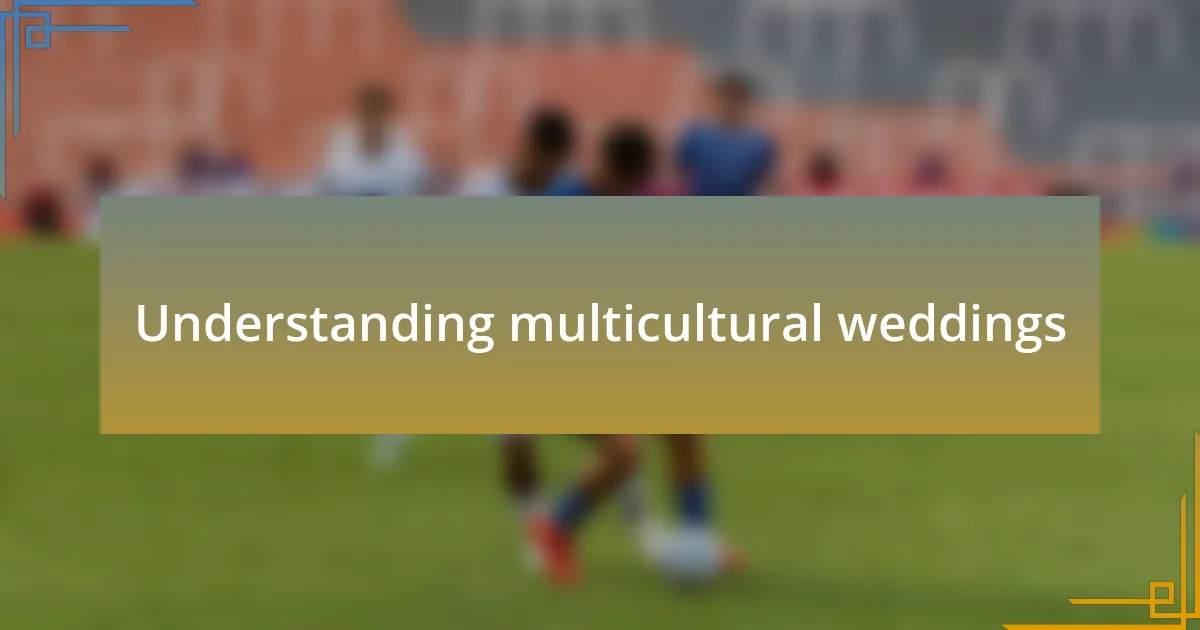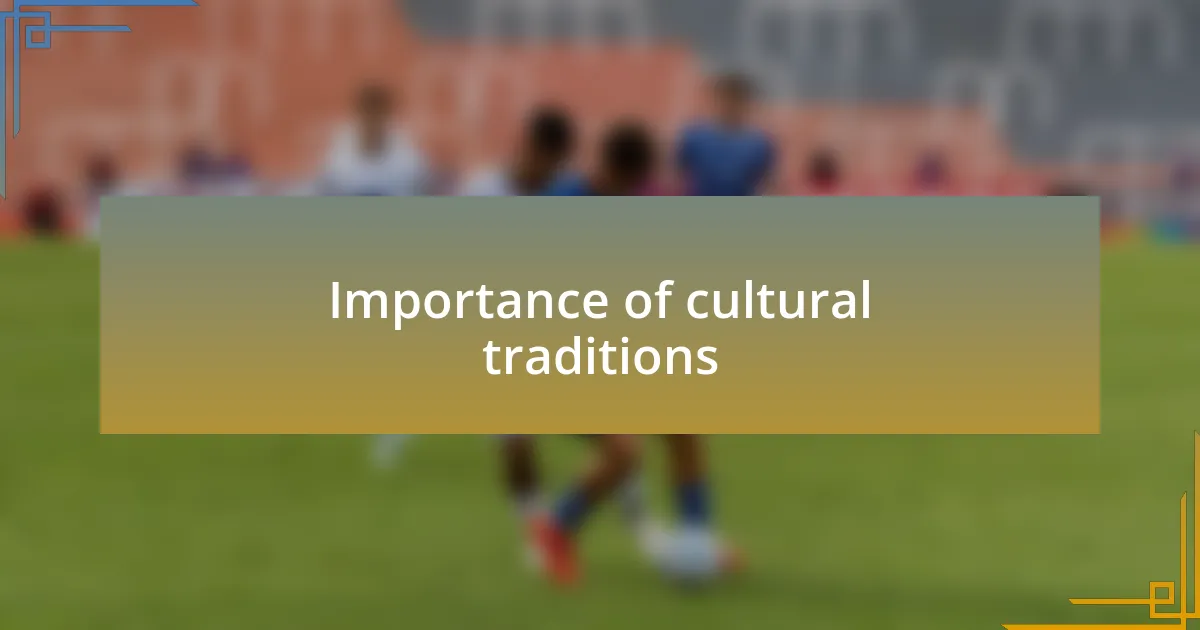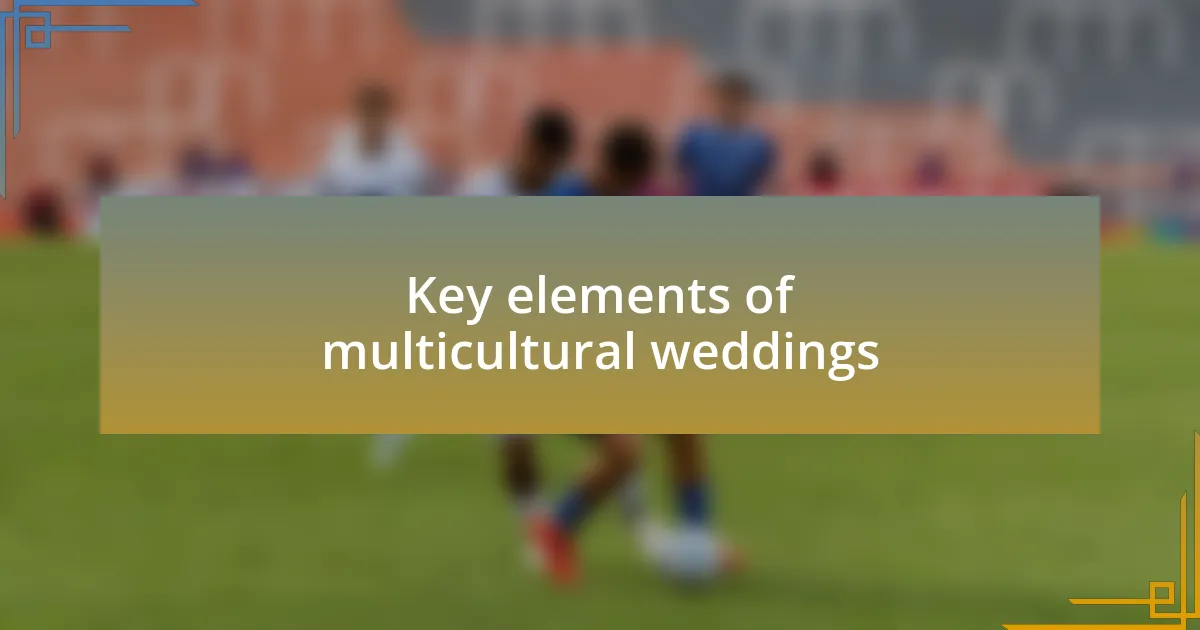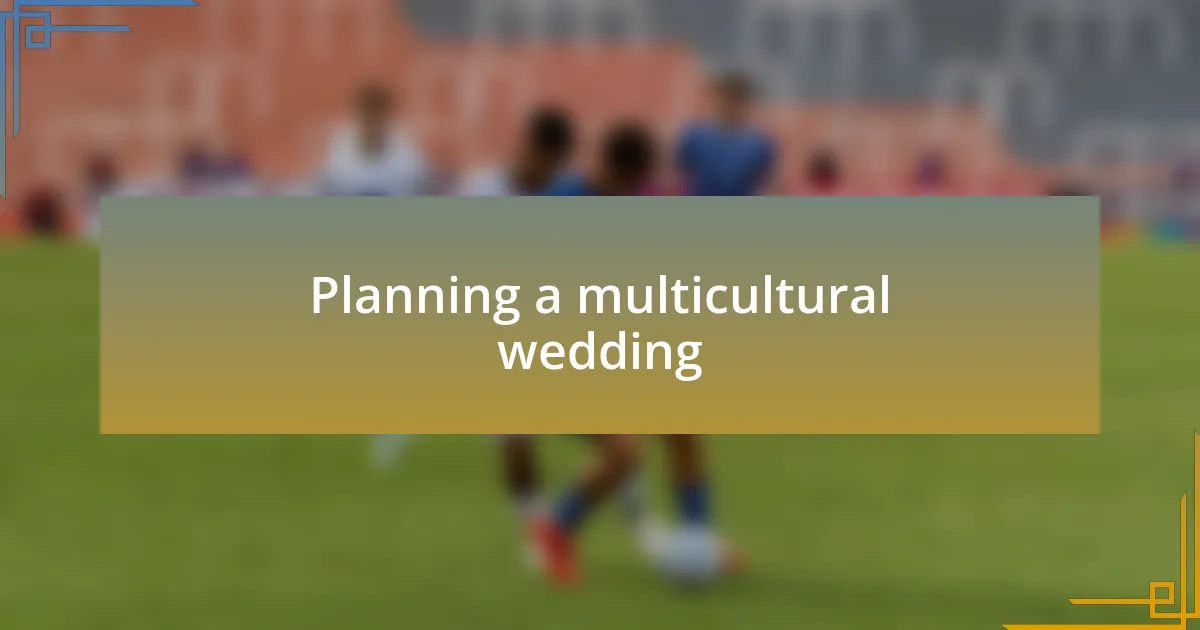Key takeaways:
- Multicultural weddings beautifully blend diverse traditions, fostering inclusivity and emotional connections among families and guests.
- Key elements include incorporating unique rituals, diverse culinary traditions, and music that transcends cultural differences.
- Effective communication and collaboration with both families during the planning process are crucial for a successful celebration.
- Flexibility and adaptability during the event can create memorable experiences, reinforcing the focus on love and joy.

Understanding multicultural weddings
Multicultural weddings are a beautiful tapestry woven from diverse traditions, often celebrating a fusion of cultures that reflects the unique backgrounds of the couple. I remember attending a wedding where the bride honored her Indian heritage with a traditional Mehndi ceremony, while the groom incorporated his Scottish roots through a bagpipe procession. It was fascinating to see how these cultural elements blended seamlessly, creating a celebratory atmosphere that was both vibrant and meaningful.
What makes multicultural weddings particularly special is the opportunity for families and friends to come together in a shared experience that transcends individual backgrounds. I often wonder, how can we best navigate the intricacies of blending traditions? In my experience, open communication between families is key, allowing everyone to contribute their cherished customs—something that adds layers of significance to the celebration.
The emotional impact of a multicultural wedding can be profound, as it often fosters a greater understanding and appreciation of different heritages. I recall a touching moment at a wedding where vows were exchanged in multiple languages. It struck me how this not only honored the couple’s respective cultures but also created an atmosphere of inclusivity that resonated deeply with all attendees. Isn’t it beautiful how love can bridge different worlds?

Importance of cultural traditions
Cultural traditions serve as the backbone of multicultural weddings, offering a way to celebrate and honor the couple’s roots. I remember sitting in awe during a ceremony where the couple exchanged not only rings but also cultural tokens—symbols that told stories of their ancestors. This act not only deepened the emotional resonance of the moment but also invited everyone present to partake in a shared cultural narrative.
In my experience, respecting and incorporating various traditions can foster a sense of unity among guests. I witnessed this beautifully when a couple decided to include a traditional tea ceremony alongside a Western-style exchange of vows. The warmth and engagement from both sides of the family during these rituals was palpable, reminding me that such traditions are more than just customs; they create connections and memories that linger long after the event has passed.
Reflecting on the rich tapestry of cultural traditions, I often think about how they enrich a wedding experience. Isn’t it powerful to imagine how these unique elements can transform a gathering into a celebration of love and heritage? When we embrace diversity in our wedding ceremonies, we invite new possibilities, allowing love to flourish in a truly inclusive manner.

Key elements of multicultural weddings
One key element of multicultural weddings is the blending of different rituals that reflect the couple’s backgrounds. I recall attending a wedding where the couple incorporated a ritual from each of their cultures, such as the lighting of the unity candle and a traditional dance. It was striking to see how these elements wove together, creating a vibrant tapestry of shared love and heritage that felt truly special.
Another essential aspect is the diversity of culinary traditions represented in the wedding feast. At one unforgettable event, guests were treated to dishes from both cultures, creating a feast that felt like a global adventure. I remember watching as everyone eagerly tried flavors they’d never experienced before—it turned a meal into a delightful journey of discovery. Don’t you think good food has a unique way of breaking down barriers and building connections?
Lastly, music plays a pivotal role in multicultural weddings, serving as a universal language that transcends cultural differences. I found it particularly moving when a DJ mixed traditional songs from both cultures, inviting everyone to the dance floor. It was heartwarming to see guests from different backgrounds come together, laughing and celebrating in unison. This reminded me that rhythm and melody can truly unite us, showcasing how love can celebrate even our most diverse identities.

Planning a multicultural wedding
When planning a multicultural wedding, it’s crucial to engage both families in the decision-making process. I remember one couple I worked with who held joint family meetings to discuss which traditions to incorporate. This inclusive approach not only eased any potential tension but also created excitement and anticipation as both sides contributed ideas that reflect their heritages. Isn’t it amazing how collaboration can transform the planning experience?
Another consideration is the choice of venue, which can greatly influence the wedding’s ambiance. I once assisted a couple who decided to hold their ceremony in a beautiful outdoor garden, where natural beauty complemented their cultural symbols. This setting allowed them to celebrate love while honoring their unique backgrounds, making the day feel intensely personal and meaningful. Have you thought about how the right location can enhance the experience for you and your guests?
Lastly, communication is key when it comes to integrating language differences. I’ve seen couples wisely include multilingual invitations and signage to ensure everyone feels included. For example, at one wedding, the couple had their program printed in both languages, providing translations for the ceremonies. It was touching to witness guests feeling welcome and engaged, as they could follow along in their native tongue. How powerful is it to make every individual feel part of the celebration?

My personal experience planning
While planning a multicultural wedding, I learned the importance of understanding each family’s customs and values. I remember sitting down with a couple whose backgrounds were worlds apart—one with vibrant Indian traditions and the other steeped in Greek culture. The process of blending their rituals was both challenging and rewarding, ultimately leading to a ceremony that felt authentic to both sides. Have you ever tried to harmonize such diverse perspectives?
Choosing the right vendors also became a significant part of my planning journey. I recall a heartfelt moment when a couple met with a caterer who not only understood their culinary preferences but also introduced them to dishes that celebrated both cultures. Watching their faces light up at the thought of sharing their beloved flavors with guests was truly rewarding. Isn’t it incredible how food can connect us across backgrounds?
Finally, I found that personal touches went a long way in creating a unique experience. One couple decided to incorporate a sand ceremony, blending colored sand from both of their cultures. As I witnessed the vibrant mix come together, it was a beautiful representation of their union. This sparked a conversation with the guests about the significance of their respective symbols, creating a deeper emotional connection for everyone involved. Doesn’t it feel amazing when a simple gesture can spark such meaningful dialogue?

Challenges faced during the process
Navigating varying family expectations can be particularly daunting. I remember one couple whose parents had different ideas about the number of guests to invite, leading to some heated discussions. It was a delicate balance, trying to honor both sides while ensuring the couple felt fully supported. Have you ever felt the pressure of making everyone happy?
Language barriers also played a role in my experiences. At one wedding, I discovered that translating vows was no easy feat. The couple wanted to maintain the depth of their feelings in both languages, and it required not just literal translation but a true understanding of sentiment. How do you convey emotion without losing the essence—especially when words alone just don’t cut it?
Of course, time management became an unexpected challenge. With so many cultural elements to weave together, deadlines felt overwhelming at times. I remember juggling intricate timelines for customs, rituals, and family gatherings, often wondering if I could pull it all off without a hitch. Have you ever experienced a situation where time seemed to slip away from you?

Tips for successful multicultural celebrations
When planning a multicultural wedding, communication is key. I once witnessed a couple who took the initiative to host a pre-wedding gathering that brought together their families to discuss traditions and expectations. This open dialogue created a welcoming atmosphere, helping everyone feel involved and respected. Have you considered how a simple meeting can lay the groundwork for smoother interactions later on?
In my experience, incorporating shared rituals can foster unity. At one wedding, the couple blended cultural customs by lighting a unity candle, symbolizing their families coming together. This thoughtful gesture resonated with both sides, allowing guests to feel included and connected. It made me realize how powerful symbolism can be in bridging different cultures. What unique elements can you intertwine to create a seamless celebration?
Don’t underestimate the importance of flexibility. I remember a wedding where impromptu changes arose when the ceremony location had to shift due to unforeseen weather. The couple’s willingness to adapt not only kept the mood light but also showed their guests that love and joy are the real focuses of the day. Have you thought about how embracing the unexpected can lead to some of the best memories?